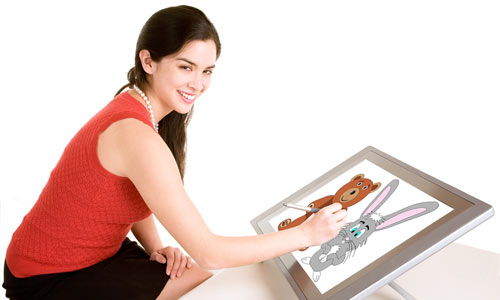Without a portfolio, it would be hard to apply for jobs and contracts online. It will also be hard to get local clients who are equally important as online clients. Both types of clients would help a freelance designer to keep going on his freelance career. A portfolio is one tool that every designer needs to get jobs. Hence, it is important to have one and maintain one. What do we mean by maintaining?
Having a portfolio is not like creating a logo that once it’s done, it’s done. A portfolio, online or hard copy, is more like creating a website that needs attention, maintenance and consistent updating. Without doing that, your portfolio will go stale. A stale portfolio will lead to a rotten freelance career and no one would like to get a rotten freelance career! You have done a lot of things to get to the top of it and you won’t allow anything pull you down. Not even your own portfolio! So, do not just dump your portfolio after creating it. Keep it fresh and work on it from time to time. Here are some tips to help you do that:
1. Update it all the time.

Of course, one sure way to have a fresh portfolio is to update it all the time. Make sure that whenever you have new designs and projects, you will add that to your portfolio. Do not be lazy to add new stuff in your portfolio because clients check on your latest designs. This is also one way of showing that you are still on the job and you are still active. Makes sure also that you have included every important detail in your portfolio.
2. Have both online and hard copy.

Before anything else, you have to see to it that you create a portfolio not just for online access but also a printed portfolio. You would need this since some people prefer to see the real product or item. Also, you would be bringing this with you when you apply for jobs. Although, your online portfolio can also be viewed using your iPad. It is still best to have both online and hard copy portfolio. Check on the 12 Tips for Creating Online Portfolio for Graphic Designers.
3. Show recent works.

When you update your portfolio you would be adding your recent works. You can choose those designs that are good because you might have done different versions of it. You can include the different versions but make sure that only those that have better designs are part of your portfolio. Remember that your portfolio has to bear the best of your works. If you do not have a new client, just continue designing and posting those designs in your portfolio. That will help you get more clients and they will also see the quality of your work. Once you design and design all the time, your work will become better giving you greater chances of getting more clients.
4. Categorize your works.

It would be easier to browse a portfolio if it is categorized well. Your clients will be able to find what they are looking for. You can think of a way on how you will categorize it. This will help you a lot especially with your hard copy since you will not find it hard to rearrange it whenever needed since you have to arrange a portfolio based on the job you are applying. That is one way of keeping it fresh.
5. Create a consistent personality.

Every designer has a different design personality. This points to how you do your work and how you signature them with the way you design. Then you have to be consistent with that. Make sure that once people will see your work, they will know it is yours. That is part of creating your own brand.
6. Let others assess your portfolio.

Well, keeping a portfolio fresh is not just about updating it. Let other people see it. Why? Because what is fresh for you would look old for others. It might no longer have an impact for them. So, make sure that you let your colleagues and friends check your portfolio. Take note of their comments and asses which ones you would apply.
7. Continue making art works.

Designing does not stop when you do not have a client. There are really slow times when it comes to freelancing and also to other kinds of businesses. When that comes, it doesn’t mean that you would stop designing. Continue creating different designs. You can make more design samples so your future clients can refer to them. Add that to your portfolio too. If you keep on making designs, you will always have something new to show your clients.
8. Include only completed designs.

It wouldn’t be good to see unfinished items in your portfolio. So, include only designs that are completed and totally done. It really won’t be a good idea to place unfinished designs. If you think it will have a good impact to the viewers of your portfolio, it doesn’t. If you are working on a project, you can post that in your blog instead and show them your workflow if you want to. Some designers do that so that the readers has something to look forward to. Blog followers tend to be curious on how the outcome of a project will be.
9. Have a coherent resume and portfolio.

It is important that the contents of your portfolio and resume are the same. If not, it would appear that you are merely making things up. So, see to it that your resume is done based on your portfolio. Do not be including items which you did not showcase in the portfolio. Other clients would check a certain project in your portfolio as stated on your CV. If it’s not there, the client will be disappointed and will not have a good impression on you.
10. Have a good design.

Last but not the least, a portfolio has to be well designed. After all, you are a designer. Your works are there to tell the clients what you can do but you also have to come up with a portfolio that can even tell them more of your skills. Your portfolio as a whole is your representation. So, make sure you will have a good design for it. See to it also that your design will stand the test of time that no matter what the trends are, it will still be in.
It’s Your Turn Now
Every designer certainly needs a portfolio. See Why Every Designer Needs a Portfolio for more points on this. But having one doesn’t end when you have completed it. You have to make sure that you will continue updating it from time to time. Let it effectively tell your clients who you are and what you can do. Are you keeping your portfolio fresh? Which steps do you do?








Awesome and difference articles…thanks to share..
Great post, you make some great points
nice tutorial..thank you.
Another thing to note, don’t be affraid to remove old or outdated work when replacing with new current work. I find it a huge turn off when designers leave early work that maybe wasn’t as polished and keep adding better, newer design. Thanks for the post!
Thanks for ready and thank you for your feedbacks! 🙂
Your right about that Brett, you have a good point. Replacing outdated designs with newer ones will certainly help you get a fresh portfolio. It will even have a better impact to clients. Thanks for sharing to us your idea. 🙂